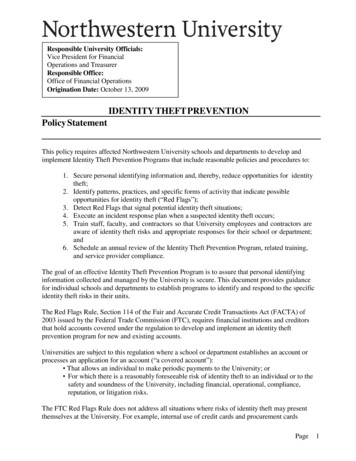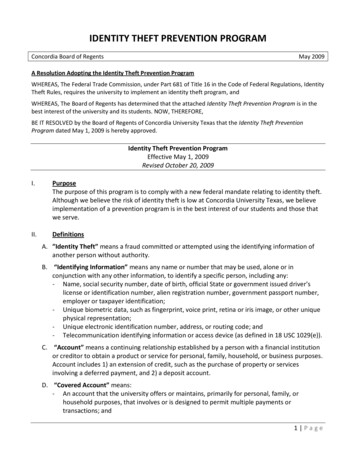
Transcription
Child Identity Theft Education Kit
Who’s at Risk?Consider a teenager who is about to start college. She hasdeposited money into a savings account and is ready to moveit into a checking account. Much to her surprise, she is denieda credit card from her bank as well as a checking account. Sheis told that her credit score is too low to get a credit card becauseshe had failed to pay off the other two credit cards she has.However, she had never applied for a credit card. She had justturned 18.Another individual is wanted for forgery as well as failure to paychild support for two children, has a suspended driving license,and has two misdemeanor charges for fighting – but he is only10 years old. His parents’ IRS tax statement states they cannotclaim their son as a dependent due to his full-time employment.After working hard in college, a young man is ready to starthis career as a computer security specialist. However, he can’tfind his Social Security card so he applies for a replacementcard. He then learns that someone is not only using his SocialSecurity number for employment, but is also collecting unemployment in another state. After checking his credit reports, theyoung man finds this person also has a car loan as well as acredit card in good standing.The three hypothetical examples above illustrate various types of child identity theft. Simply put, thiscrime occurs when an individual uses the identifying information of a child for personal gain. Thatinformation can include Social Security numbers, mother’s maiden name, date of birth, location ofbirth, and even just the name and address of the child.2 of 7
Child identity theft can be discovered whenchildren are still young or after they reach 18years old (or are emancipated) and start to usetheir own information and build a credit history.In the case of young children, the parents are usually the first to realize there might be a problem.They might receive calls from collection agencies, get a rejected federal or state tax form, or receivepre-approved credit card offers directed to their child. Their teen may be denied the right to a driver’slicense due to accumulated tickets or even receive notice of a valid driver’s license in their state oranother state.Almost all adult-child identity theft victims find out in a negative manner. They are denied credit,loans, tenancy, and even a job. They aren’t able to sign up for utilities like cable or phone service,are terminated from employment without cause, receive bills for credit cards they never requestedor received, and may even be arrested for the crimes of another person.Who Typically Steals a Child’s Identity?Currently there are two categories of people who are stealing and usingchildren’s identifying information. Unknown perpetrator: These thieves have either stolen or purchasedthe Social Security number and sometimes other identifying information of a child. Some people create Social Security numbers that justhappen to belong to a child. Family members: A reality of child identity theft is the fact that parents or family members of a child have been found to use the child’sidentifying information, often in times of desperation. Be it job loss ormounting debt, they are compelled to take advantage of their child’s“clean” credit history. They may open new lines of credit using thechild’s SSN to help pay off bills, and perhaps have never learned tolive within their means and are unable to pay off current credit cards.3 of 7
How Do Imposters Use Stolen InformationThe primary use of stolen identifying information is for financial purposes. It can also be used formany other purposes. Here are some examples of both: Open a bank account or checking account Apply for credit/debit cards and loans, including tuition/student and car loans Apply for utilities, such as cellular phone, cable and Internet services Rent an apartment Get a job Use the child’s SSN as the family SSN due to the inability of a parent to get a SSN Avoid a criminal record on the perpetrator’s file Avoid a medical record with the perpetrator’s file information (perhaps for insurance purposes or to hidea medical condition) Fraudulently receive welfare, unemployment or medical benefits4 of 7
Safeguarding Your Child Starts at HomeIt is important to protect your child’s Social Security number and birth certificate. Hold your children’s personal information as closely as you hold them. The suggestions below can help protectyour child’s identity: Carry your child’s Social Security card, birth certificate or passport with you only whenabsolutely necessary. Unless you initiate contact, do not provide your child’s Social Security number (or any part of it) overthe phone, over the Internet, or in person. If you are asked for your child’s Social Security number ask these three questions: Why is it needed? Isn’t there another way to identify my child? How will my child’s information be protected? Lock birth certificates and documents with your child’s Social Security number in a safe place. Purchase and use a cross-cut shredder. It is important that you talk with your children about identity theft. Create a safe environment withopen dialogue. Explain it in terms they can understand, using examples such as “defensive driving”or “expensive jewelry”. Leave the door open for them to ask questions or express concerns. Sign up for an identity protection and credit monitoring service such as the Equifax Complete Family Plan. This type of service is a proactive tool to not only monitor your credit files and protect your family’s identities, but also to receive alerts if there is any activity reported on yourchild’s Equifax credit file. More information is available at www.equifax.com. Most schools ask for personal identifying information. Ask if this is optional or if another form of identification such as a utility bill is sufficient. Never use your child’s Social Security number to open accounts for your benefit. This may betempting if you have bad credit, but not paying bills on time could keep your child from gettingcredit cards, student loans, an apartment, or even a job when they turn 18.5 of 7
Internet Safety and Your Child It’s important to teach your child not to give out personal informationover the phone, as well as not to post any information on the Internet.Children and teenagers are likely to post personal identifying informationon social networking sites. Know the web sites your child visits. Find out what type of informationis being requested to register or to create a profile. Talk to your childabout the risks of posting personal information in a public forum. Protect computers from viruses, malware, and spyware. Alwaysupdate firewall and virus protection software. Teach your child to password-protect their log-in information. Teachyour child about creating safe passwords. Talk with your child about scams they might encounter over thephone, on social sites and over the Internet/smartphones via adsor emails.6 of 7
Resolving Child Identity Theft CasesFirst Steps to Take: Contact the local police and report the crime with any evidence you have: credit cards,bills, collection notices, and letters from the IRS or any other governmental or law enforcement agency. Get a report from the police, not just an investigation number.For Financial Identity Theft: Using a copy of the police report, request a copy of any information known by the three creditreporting agencies. The request will need to be in writing and in compliance with the currentrequirements of each agency. Contact any credit issuers or collection agencies listed on the credit report or that have been incontact with the victim. Explain that this is a case of child identity theft and that the contractis not binding due to the age of the child at the time the contract was written. Ask to have all accounts, application inquiries and collection notices removed immediatelyfrom your child’s credit report. You can do this via the credit issuer or through a dispute process with the credit reporting agencies. In the end, the credit issuer is the final decision makeras to whether to accept the claim of fraud or not. Request copies of all application and transaction records. According to federal law, they mustmake those documents available to the victim/parent when a police report has been submittedwith the written request. Make copies and provide those to the police investigating the case.They may help you discover how this crime occurred.For Other Identity Crimes: In the area of criminal identity theft, you may need to provide an alibi for your children(i.e., school attendance records; doctor’s appointments). If you believe the imposter has obtained employment using the child’s SSN, contact theSocial Security Administration and request a copy of the “child’s work statement- form7040”. It will list all the places “the person has worked.” You then need to ask to havethat document amended, explaining this is a case of child identity theft.7 of 7
happen to belong to a child. Family members: A reality of child identity theft is the fact that par-ents or family members of a child have been found to use the child's identifying information, often in times of desperation. Be it job loss or mounting debt, they are compelled to take advantage of their child's "clean" credit history.










